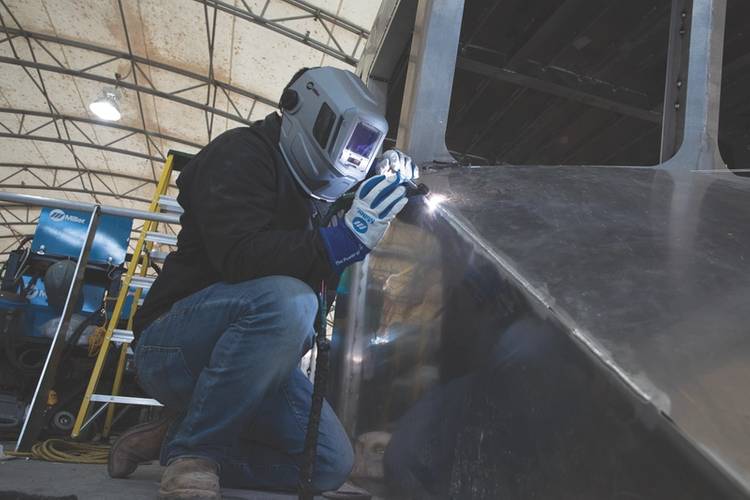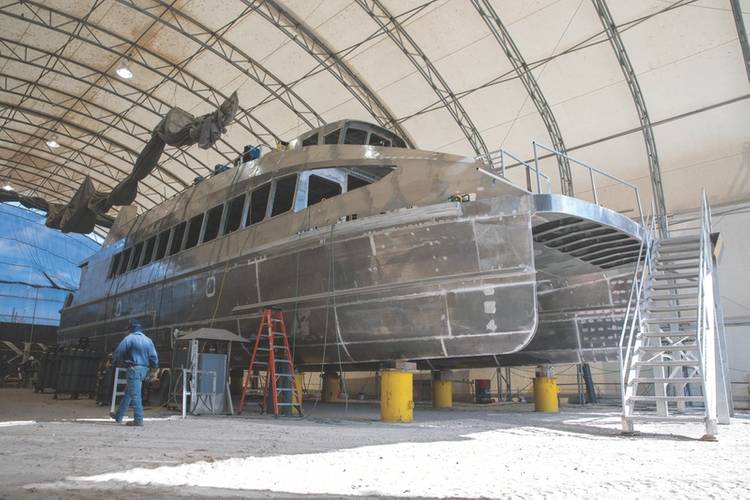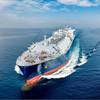'Best of the Best' Welds Help Metal Shark Succeed, Expand
Louisiana-based shipbuilder eliminates preheat and saves time with Dynasty 400 TIG welders.
As a well-known shipbuilder specializing in the design and production of vessels, Metal Shark Boats doesn’t shy away from tackling tough and diverse jobs. It’s a philosophy that has fueled the company’s growth from small shop to major industry player.
Launched more than three decades ago as a small family-owned operation crafting custom fishing boats, the transition to Metal Shark Boats began in 2003 after the company was approached to produce aluminum patrol boats and work boats for military and law enforcement customers.
Building on its reputation for vessel production for the U.S. military and allies around the world, Metal Shark has expanded its focus to include state, local and commercial operators in a range of markets, including fire rescues, law enforcement, passenger vessels, pilot boats, specialty vessels and recreational boats. The Louisiana-based company now has more than 400 employees and nearly 1,000 boats in service.
The 2014 opening of a second facility — a shipyard in Franklin, Louisiana, with direct access to the Gulf of Mexico — helped further the company’s expansion into passenger vessels and large ships, including ferries and survey boats. Metal Shark now has the capability to build vessels up to 250 feet long.
“We continue to diversify our business, to where we are able to build larger, more capable vessels,” says Greg Lambrecht, Metal Shark executive vice president. “Because of our engineering-centric capabilities, we’re not afraid to tackle any job that comes our way. We can design and build whatever the customer wants.”
With a focus on engineering and a large in-house design team of naval architects and marine engineers, Metal Shark offers a full portfolio of its own designs and the ability to customize each one to meet a wide range of needs.
Tackling intricate builds or projects with demanding timelines requires the right personnel and the right equipment to turn out high-quality finished products. Metal Shark recently invested in five Dynasty 400 TIG welders from Miller Electric Mfg. LLC. The machines allow the company to weld thicker materials without preheating — saving time and improving productivity, while still maintaining strict quality requirements.
The best of the best welds
Metal Shark’s Franklin Shipyard facility was designed to accommodate the latest serialized production methodologies. Three separate assembly buildings enable the weather-independent construction of vessels up to 200 feet in length. The facility also has protected deep water berths, crane-in/crane-out launch facilities, over 8,000 square feet of office space for engineering, project management, and administrative staff, and room for storage and staging. A new 160-ton Marine Lift transporter facilitates the movement of boats around the yard and to water for launch. Metal Shark’s Franklin yard is one of the most modern and capable shipyards along the Gulf Coast.
Quality and meeting customer needs are driving forces for Metal Shark. Even on jobs with demanding turnaround times, the company won’t sacrifice quality or customer satisfaction for speed.
“We always keep an eye on what’s best for the customer, what’s best for the quality,” Lambrecht says.
As Metal Shark transitioned from a small boat production facility to a shipyard, welding became even more critical to the operation. It was important to build a workforce of skilled welding operators and choose the right welding equipment and processes to help them produce high-quality finished welds to meet codes, inspections and customer demands. Metal Shark operators use TIG welding on aluminum and stainless steel for many of the vessel builds.
“We need the best machines with the best settings to be able to keep up with the quality of all the boats,” says Blake Stovall, TIG welding operator and supervisor at Metal Shark’s Franklin Shipyard. “Quality and consistency are really important. We do a lot of the main features of the boats that everybody is going to see, so we want the best of the best of welds.”
Eliminating the need for preheat
Producing the high-quality welds means staying on the leading edge of welding technology and solutions. Metal Shark has for many years used Miller welding equipment in its operation, including Dynasty 350 TIG welders.
Taking the next step to invest in Dynasty 400 TIG welders provided the company with more amperage and greater versatility. The extra amperage of the machines delivers more heat on demand for welding operators, allowing them to eliminate preheating when welding thicker materials. “We don’t have to really use preheating as a source of heat before we weld, because of the extra amps that the 400 offers,” says Karl Prados, general manager and CWI at Metal Shark Boats. “Start time is cut in half.”
Eliminating the preheat process saves significant time for Metal Shark, and allows welding operators to keep their hood down and remain focused on the weld.
“That can be the difference between 30 minutes of preheating or just taking off and welding,” Stovall says. “Because we’re welding on so many different thicknesses, we keep our amperages pretty high, so if we need the heat it’s there, rather than having to go back and forth to the machine.”
Tailoring the arc
Achieving the best results when welding aluminum requires the ability to fine-tune and control the arc. With the Dynasty 400 TIG welders, Metal Shark welding operators can easily adjust arc characteristics for specific applications and electrodes. Balance control provides adjustable oxide removal, which is essential for creating the highest quality aluminum welds. In addition, operators can use frequency to control the width of the arc cone and improve directional control of the arc.
“The machines help us with the quality, because we do it right the first time around,” Stovall says. “We don’t want to go back and do any repairs.”
Another technology helps keep the machines cleaner — saving time while also reducing noise. The Fan-On-Demand cooling system in the welding power sources operates only when needed. Compare this to other cooling systems that run constantly — even when the operator isn’t welding — which means the system fans are constantly pulling dust particles, dirt and contaminants into the machine.
“We have a lot of dust and sand in the atmosphere,” Stovall says. “It helps keep the machine cleaner because it’s not running constantly.”
Adding to the machines’ quieter and cleaner operation, as well as its versatility, is the Cooler-on-Demand feature in combination with the Coolmate 3.5 cooler, which connects to an integrated 120-volt dedicated-use receptacle for power. A power switch on the machine activates the receptacle to help prevent failure when using a water-cooled torch, while the Cooler-on-Demand feature operates the auxiliary cooling system only as needed. This function not only reduces noise and minimizes the airborne contaminants being pulled through the cooler, but it also helps lower energy use.
The right equipment for quality welds
Training operators on the new machines was a simple transition for Metal Shark. The easy-to-use interface offers intuitive operator control, while program memory features nine independent program memories that maintain and save operator parameters.
“The Dynasty 400s are so user friendly. It makes it easier for training, and it makes it simple to get a good quality weld,” Prados says. “After 20 years in welding, I’ve never found a machine that welds as good as the Dynasty. The quality is better than anything we’ve ever tried.”
Choosing the right equipment helps Metal Shark welding operators produce high-quality welds and meet customers’ demands — factors that have been critical to the company’s growth and success.
“Working with Miller through this entire thing has been a key to our success,” Lambrecht says.
The Author
Andrew Pfaller is a Product Manager at Miller Electric Mfg. LLC, a global provider of welding equipment and manufacturing. Based on a foundation of real-world welding, Pfaller achieved a BS in Welding Engineering Technology prior to starting his career as a Welding Engineer at Miller in 2012. Andrew is an AWS CWI and manages the current portfolio and leads customer-back new product development for the TIG Solutions Division.
(As published in the April 2018 edition of Marine News)















